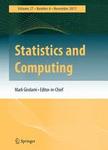版权所有:内蒙古大学图书馆 技术提供:维普资讯• 智图
内蒙古自治区呼和浩特市赛罕区大学西街235号 邮编: 010021

作者机构:Univ Bologna Dept Stat Sci Via Belle Arti 41 I-40126 Bologna Italy
出 版 物:《STATISTICS AND COMPUTING》 (Stat. Comput.)
年 卷 期:2018年第28卷第1期
页 面:145-169页
核心收录:
学科分类:0202[经济学-应用经济学] 02[经济学] 020208[经济学-统计学] 07[理学] 0714[理学-统计学(可授理学、经济学学位)] 0812[工学-计算机科学与技术(可授工学、理学学位)]
主 题:Clusterwise linear regression EM algorithm Gaussian mixture model Genetic algorithm Multiple cluster structure Variable selection
摘 要:In the framework of cluster analysis based on Gaussian mixture models, it is usually assumed that all the variables provide information about the clustering of the sample units. Several variable selection procedures are available in order to detect the structure of interest for the clustering when this structure is contained in a variable sub-vector. Currently, in these procedures a variable is assumed to play one of (up to) three roles: (1) informative, (2) uninformative and correlated with some informative variables, (3) uninformative and uncorrelated with any informative variable. A more general approach for modelling the role of a variable is proposed by taking into account the possibility that the variable vector provides information about more than one structure of interest for the clustering. This approach is developed by assuming that such information is given by non-overlapped and possibly correlated sub-vectors of variables;it is also assumed that the model for the variable vector is equal to a product of conditionally independent Gaussian mixture models (one for each variable sub-vector). Details about model identifiability, parameter estimation and model selection are provided. The usefulness and effectiveness of the described methodology are illustrated using simulated and real datasets.